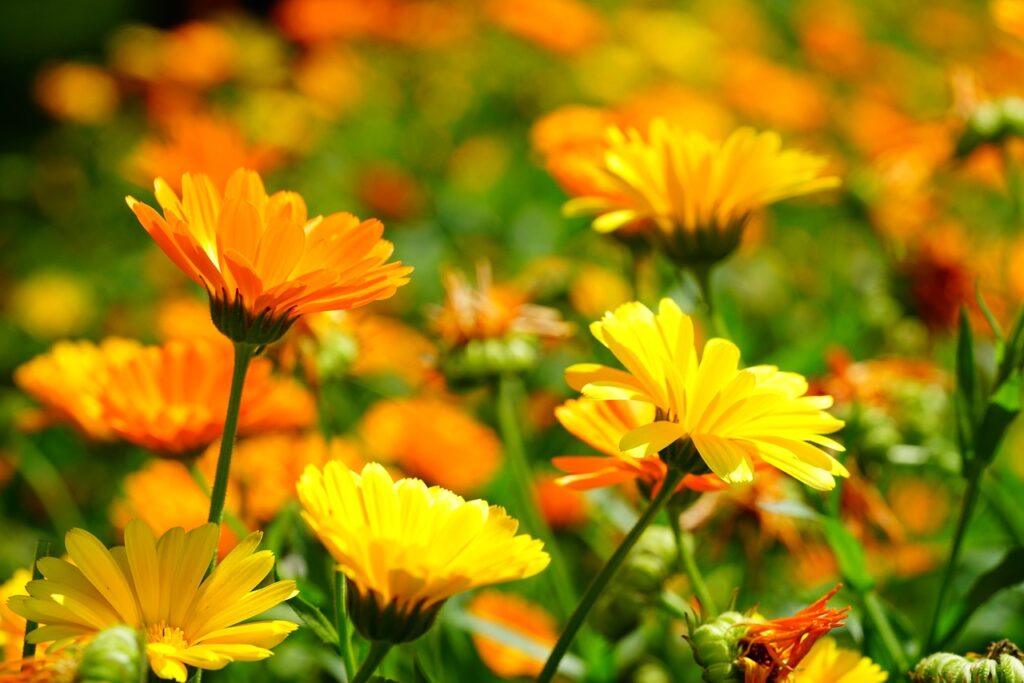Marigolds are a popular and versatile plant that are enjoyed by gardeners and nature lovers around the world. With their bright, sunny flowers and many uses and benefits, marigolds are a true treasure of the natural world. In this article, we will explore the world of marigolds, from their various types and species to their history, uses and benefits, symbolism, planting, care, and interesting facts.

General Information
Marigolds are flowering plants that belong to the Asteraceae family. They are native to Mexico, but are now grown in many countries around the world. Marigolds are known for their bright, sunny yellow or orange flowers, which are often used in bouquets, arrangements, and as ornamental plants. They are also valued for their edible seeds, which are used in a variety of foods and products.
Types, Species, and Hybrids
There are many different types of marigolds, including:
- Common Marigolds (Tagetes spp.): These are the most common type of marigold, with a wide range of colors and sizes. They are often grown as ornamental plants and for their edible seeds.
- French Marigolds (Tagetes patula): These marigolds are smaller and more compact than common marigolds, and are often used in containers and as border plants.
- African Marigolds (Tagetes erecta): These marigolds are taller and have a wider spreading habit than common marigolds, and are often grown as cut flowers.
- Calendula (Calendula officinalis): Also known as pot marigolds, these are a different plant from common marigolds, but are also members of the Asteraceae family. They are often used for their edible flowers and medicinal properties.
History
Marigolds have a rich history that dates back thousands of years. They were first cultivated by the Aztecs in Mexico, who used them as a medicine and as a ceremonial offering to the sun gods. Marigolds were later introduced to Europe, and have been a popular garden plant and crop ever since.
Uses and Benefits
Marigolds have many uses and benefits, including:
- Ornamental Use: Marigolds are grown for their beautiful flowers, which are used in bouquets, arrangements, and as landscape plants.
- Edible Seeds: Marigold seeds are rich in nutrients, including protein, healthy fats, and vitamins and minerals. They are used in a variety of foods, including snacks, baked goods, and as a topping for salads and other dishes.
- Medicinal Use: Marigold flowers and seeds have been used in traditional medicine for centuries, and are believed to have anti-inflammatory and antioxidant properties.
- Pest Control: Marigolds are known to repel certain pests, and are often used as a companion plant to protect other plants from insect damage.
- Decorative Use: Marigold petals are edible and can be used to add color to salads and other dishes, or to make tea.
Symbolism
Marigolds have many symbolic meanings, including:
- Longevity: Marigolds are often associated with longevity and vitality, as they are able to grow tall and strong.
- Happiness: Marigolds are often used to symbolize happiness and cheerfulness, as their bright, cheerful flowers are sure to bring a smile to anyone’s face.
- Loyalty: Marigolds are sometimes used to symbolize loyalty and faithfulness, as they always face the sun and never wilt or lose their brightness.
Planting and Care
Marigolds are relatively easy to grow, but they do require some care. Here are some tips for planting and caring for marigolds:
- Choose the Right Location: Marigolds need full sun and well-drained soil. Avoid planting them in low-lying areas where water may accumulate.
- Plant at the Right Time: Marigolds are best planted in the spring, when the weather is warm and the soil is moist.
- Prepare the Soil: Marigolds prefer loose, well-drained soil that is rich in organic matter. Add compost or other organic matter to the soil before planting.
- Water Regularly: Marigolds need regular watering, especially during the hot summer months. Avoid overwatering, as this can lead to root rot.
- Fertilize Regularly: Marigolds need regular fertilization to grow and bloom well. Use a balanced fertilizer, following the package instructions.
- Prune Regularly: Marigolds need regular pruning to promote new growth and prevent disease. Prune in the late winter or early spring, before new growth begins.
Interesting Facts and Trivia
- Marigolds are able to track the sun, turning their flowers to face the sun throughout the day.
- The tallest marigold on record reached a height of 9.17 meters (30 ft 1 in).
- Marigolds are part of the Asteraceae family, which also includes daisies, chrysanthemums, and marigolds.
- Marigold petals are edible and can be used to add color to salads and other dishes, or to make tea.
Conclusion
Marigolds are a beautiful and versatile plant that have been cherished for thousands of years. Whether you are a gardener, a farmer, or just someone who loves flowers, there is something about marigolds that will capture your heart. With their bright, cheerful flowers, many uses and benefits, and rich history, marigolds are a true treasure of the natural world.
FAQs
- What is the difference between a marigold and a flower? A marigold is a type of flower that belongs to the Asteraceae family, while a flower is a reproductive structure found in many different types of plants.
- What are the different types of marigolds? There are many different types of marigolds, including common marigolds, French marigolds, African marigolds, and calendula.
- What are the benefits of growing marigolds? Marigolds have many benefits, including providing beautiful flowers for ornamental use, edible seeds for food and oil, and medicinal properties. They are also known to repel certain pests and can be used as a companion plant to protect other plants from insect damage.
